












Zoo Brew
7-10 p.m.

Enjoy hops by the hyenas or a malt by the macaques. Zoo Brew is the Zoological Society’s annual beer and food tasting event inside the Milwaukee County Zoo. There will be three zones around the Zoo for you to pick up your favorite brew or try something new. Guests can grab samples at the outdoor beer garden near the U.S. Bank Gathering Place, at Florence Mila Borchert Big Cat Country or at the Peck Welcome Center where you will also be treated to live music. Entertainment and beverages are sponsored by Molson Coors.
Purchase a VIP ticket to enter the event one hour early or buy a designated driver ticket and enjoy the food samples, non-alcoholic options, entertainment and a fall evening at the Zoo. Tickets can be bought at GoZooBrew.com.
Zoo Pass Members & Guests Cost:
Regular Ticket: $60
VIP Ticket (early entry at 6 p.m.): $70
Non-Members:
Regular Ticket: $75
VIP Ticket (early entry at 6 p.m.): $85
Designated Driver: Regular Ticket:

We value your relationship with the Zoological Society of Milwaukee (Society). The Society does not sell member/donor information to third parties but may share limited information with the Milwaukee County Zoo for the purpose of confirming membership status.
Zoo hours:
Now through Sept. 2 – 9:30 a.m.-5 p.m.
Sept. 3 through Oct. 31 – 9:30 a.m.-4:30 p.m.
Zoological Society office hours:
Now through Sept. 2 – 8:30 a.m.-5 p.m.
Sept. 3 through Oct. 31 – 8:30 a.m.-4:30 p.m.
Please Note: The following areas close before the posted Zoo closing time: drive-in admission gate (45 minutes prior), walk-in gate (one hour prior) and animal buildings (15 minutes prior).
Zoo Pass admission: Please remember to have your Society Zoo Pass and identification ready when you arrive at the Zoo’s admission gates. If you’ve misplaced or lost your card, replacement cards may be purchased for $5. Zoo Pass admission is valid for regular daytime Zoo hours and many events.
Please remember the person(s) named on the Zoo Pass must accompany any guest if there are guest privileges on the Zoo Pass card.
Visiting other zoos and aquariums: We participate in the Association of Zoos and Aquariums’ listing of accredited institutions. Some accredited zoos and aquariums choose not to participate in this program and therefore do not appear on our list.
Most facilities honor free or discounted admission for two adults and two minor children. Members should call ahead to the facilities they plan to visit to get current information. In a few cases, we have opted not to reciprocate with some institutions that are in close proximity to our Zoo. Members are encouraged to review the updated list by going online at www.zoopass.com
Who can use member cards? The person(s) named on the Zoo Pass is the owner of the card, and benefits are not transferable to anyone else. We need to have the number of members’ minor children/ grandchildren in your household reflected in your membership records for the Zoo’s admission gates. Foster children are covered on your membership.
Day-care providers for children: Your Zoo Pass membership does not cover children for whom you provide baby-sitting or day-care services. The Society and the Zoo retain the right to invalidate any membership being used inappropriately.
No. 169, Sept.-Oct. 2024
Ride on the Wild Side Sponsored by Lifeway 7 a.m.-1 p.m.
Grab your helmet and get ready to go biking by bears and cruising by caribou. Ride on the Wild Side is the one time each year you get the chance to ride your bike through the Zoo. Take a nice leisurely ride on the family-friendly 2.5-mile route, or push yourself with the 10-, 17- or 27-mile routes. All riders will receive a long-sleeved T-shirt, breakfast, lunch and a day at the Zoo. Electric bikes and bike trailers are permitted at the event.


Fdistinctive that some people refer to them as pig-nosed turtles. They are also the only freshwater turtle species that have flippers — just like a sea turtle!
The Milwaukee County Zoo is home to one of these unique turtles, and now you can help support Penny, the Fly River turtle! For the Society’s new, limited-time offer, a $50 animal sponsorship of Penny will give you a plush-toy turtle, a colorful fact sheet on Fly River turtles, an invitation to a behind-the-scenes* event for animal sponsors, a one-year subscription to Wild Things newsletter and Alive magazine and more! This package will become available on Aug. 24, so make sure to mark your calendar to help support Penny.
Learn more about Penny the Fly River turtle on page 8!

Animal sponsorships can make great gifts for any occasion. To order one today, visit zoosociety.org/SponsorAnimal or call 414-258-2333.
At the Aquatic & Reptile Center, as you walk by the underwater habitats you would expect to see fish swimming around and interacting with each other. But, occasionally, you might walk by one of these habitats and be surprised to see scuba divers swimming among them.
According to Melissa Spreda, ARC area supervisor, the animal care team will don their scuba gear when they go in to clean the Pacific, Amazon, Lake Wisconsin and African Lakes habitats. Spreda says that each habitat is a little different in what is required to clean them and how often they need to be cleaned. The Pacific habitat, for example, is cleaned once a month, making it the most frequently cleaned of the underwater habitats.
Cleaning the Pacific habitat requires a fourperson dive team, Spreda says. There are
two divers in scuba gear that go down into the habitat and use a power scrubber to get rid of algae on the walls, window and rocks. While the two divers are cleaning, a third team member is stationed above the habitat to help the divers get in and out or help communicate anything the divers need. Meanwhile, a fourth person watches from the public side through the glass to get a better visual of the divers and see if anything needs to be communicated to them.
But where are the fish while the habitat is being cleaned? While it may seem empty in there, Spreda says that they will tend to swim around the bottom of the habitat while waiting for the divers to finish cleaning up their home.
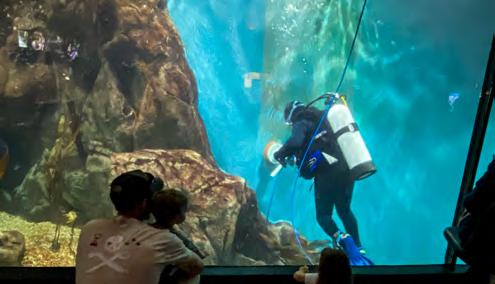


Meet Mai, the newest and tiniest member of Milwaukee County Zoo’s Japanese macaque family, born into a lively group of nine. Her name, “Mai,” (pronounced may) is a Japanese word meaning “dance” or “brightness,” and it suits her perfectly. This little bundle of joy can often be seen bounding around her
The spotlight on baby Mai has stirred other emotions in the troop. Rikka’s older daughter, Sora, sometimes snuggles up extra close to her mom and baby sister, eager to be part of the cuddles and affection. It’s a fascinating glimpse into the social dynamics of macaques. Next time you visit the Zoo, make sure to stop by
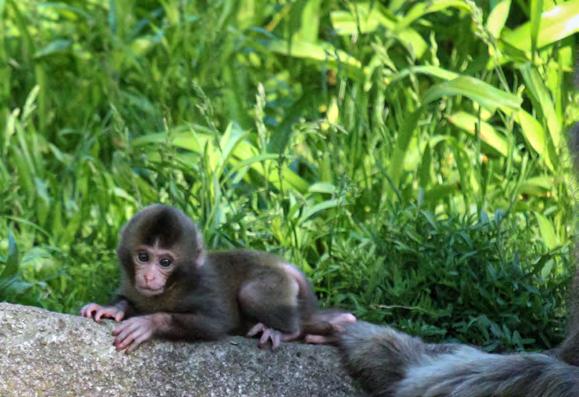


Getting a look at a veterinary procedure is now even more up close and personal. With the help of a new camera that can pan, tilt, and zoom in on animal procedures, guests can now enjoy even better views of the treatment room inside the Animal Health Center at the Milwaukee County Zoo.



Veterinary Views are opportunities for any guest to witness a procedure on an animal. Recent patients included an opossum and a Hoffman’s two-toed sloth, both animals who would have been hard to see from the observation area because of their size. Many guests, including children and families, marveled at the vet team’s work via two large flat-screen TV monitors. These monitors show a live feed from the new camera mounted on the ceiling above the operation table.
The camera is controlled by Zoo Pride volunteers, who are there to provide supplemental information and tell you all about the animal receiving treatment. The Animal Health Center is off the routine path for many Zoo guests. In the summer, a public entrance to the building is located inside the Zoo next to the flamingos. Vet Views can happen any day of the week and tend to be scheduled around 9:30 a.m. Be sure to check

the flat screen TV in the U.S. Bank Gathering Place across from the Coffee Shop for the schedule. Schedule is subject to change.
These new upgrades, including the TVs and the remote-controlled camera, were donated to the Milwaukee County Zoo’s Animal Health Center by Chris Robert Smith and Zoo Pride volunteers Jeff Schwager, Joicelyn Schwager, Steve Mageski and Mary Zelenka.

They purchased the new equipment and collaborated with the Zoo’s maintenance team to install it for an enhanced guest experience. Future hopes include a second camera installed so guests can get a feed of the X-ray room!
OCT 5 NOV 2 DEC 7
Family Free Day
9:30 a.m.-4:30 p.m.
Sponsored by Tri City National Bank Media Sponsor: FOX6
A trip to the Milwaukee County Zoo is a great way to spend any day. You know what’s even better? A free day at the Zoo! Family Free Days are back at the Zoo, as everyone will receive free admission to the Zoo on the first Saturday of October, November and December (Parking and concession fees still apply*). So, load up the car and come on down to the Zoo to see all your favorite furry, feathery, scaly and slimy animals.
*Zoo Pass Plus and Platypus Circle members get free parking.

Each year the Zoological Society picks an animal to feature as an ornament.
This year, for the first time, we are honoring the animals inside the Northwestern Mutual Family Farm by showcasing Trinity, the Scottish Highland cow. Trinity is 13 years old and came to the Milwaukee County Zoo in 2015.
You can see Trinity in her habitat with Carnation, the Belted Galloway cow. Highland cows have horns that are used to help them forage for food during the winter. They are hardy, gentle and have uniquely shaggy coats. A downy undercoat and long outercoat insulate them against harsh climates. Their hair can sometimes reach up to 13 inches long!
This year’s ornament showcases Trinity’s long hair and horns. Local artist Andy Schumann handcrafts each year’s ornament in clay before turning the mold into a beautiful pewter ornament. This is the 33rd ornament in the Society’s collection. Each ornament is $16 including tax, shipping and handling. Visit zoosociety.org/ornaments for a look at available options.
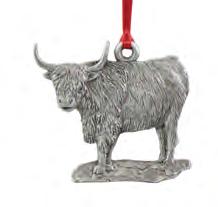
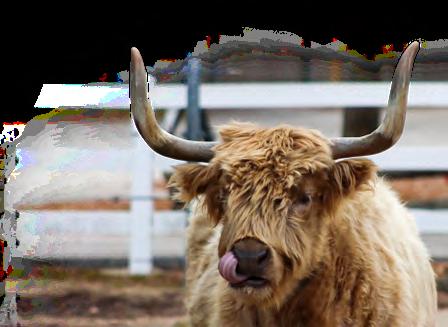
There are many people who think a penny can be a good luck charm. While there are no coins in the Aquatic & Reptile Center, you can still find a “lucky Penny” in the African Lakes habitat.
Penny, the Zoo’s Fly River turtle, arrived at the Milwaukee County Zoo in 2012 after a long journey that began in 2004. Penny, along with 12 other turtle hatchlings, was confiscated from an animal smuggler by the U.S. Fish and Wildlife Service at the Los Angeles International Airport. Penny and the other hatchlings were sent to the Los Angeles Zoo to
“She really likes to carry that around in her mouth. You’ll see her swimming by and she’s just holding this kelp in her mouth,” Spreda said. “We have to be really careful with what we put in there because she really likes it. We’ve tried putting some plastic plants in there, and like a naughty puppy she goes and chews them up.”
While Penny happily swims around and enjoy her favorite foods and enrichment activities (she loves her puzzle feeders and fruit frozen in ice) other Fly River turtles that are smuggled to be sold as pets are not as lucky. Besides the fact that these animals should be left alone in their native range in the first place, Spreda says that it’s just not feasible for people to properly take care of them at home, especially since Fly River turtles can grow to be up to 50 pounds.
“You can’t go down to a “pet store” and and get a 55-gallon tank and call it good for a Fly River turtle. It’s just not going to work,” Spreda said. “Turtles in general — especially aquatic turtles — are very, very messy.

receive care, before they eventually found homes at other organizations. Melissa Spreda, ARC area supervisor, said that once the turtles were removed from their homes by smugglers, they could not be returned to their natural range.
“Turtles have very site-specific ranges. For example, sea turtles will nest on the same beach they were born on. So you couldn’t put it somewhere in the ocean and hope that it’s magically going to find its way back to its beach,” Spreda said. “A lot of other turtles are the same way. They have a specific home range imprinted even before they’re born, so it’s important to get them back to the same spot, and kind of impossible in a smuggling scenario.”
When Penny first arrived at the Zoo, she was originally going to remain behind the scenes and only be seen as part of educational programs. But then around 2017, it was decided that Penny would be a good fit to live in the African Lakes habitat. Although the Fly River turtles’ natural range is in northern Australia and southern New Guinea, Spreda said that the water temperatures and water parameters in the African Lakes habitat are very similar to those in their natural environment, making the habitat a good fit for Penny.
Nowadays, Penny enjoys swimming around the habitat and chasing after her fishy neighbors or watching through the glass to see what the people outside her habitat are doing. Figs and strawberries are her absolute favorite foods, and Spreda says that Penny also enjoys grabbing things in her habitat — like some fake kelp — with her mouth.
Fly River turtles are the only freshwater turtles that have flippers — similar to those on sea turtles!
While they are not considered softshell turtles, Fly River turtles have a similar, leathery skin that covers their shell.
Their large, fleshy noses are perfect for pushing around rocks and other objects while rooting around and smelling in the sand for tasty foods like plant matter and snails.
It’s hard to maintain water quality. So we have a massive filter that is in our basement that filters that habitat. Home aquariums struggle to replicate something of that size … There’s just a lot that goes into setting up any reptile, and especially turtles in particular.”
While that means that Fly River turtles don’t make good pets, you can still say hello to Penny and enjoy watching her happily swim through her habitat the next time you visit the Zoo. You can sponsor Penny this fall and receive a plush-toy turtle.
Read page 4 to learn more!
Throughout the year, there are dozens upon dozens of days that are dedicated to celebrating and learning more about a wide variety of animals. This year, Oct. 25 is World Lemur Day, which means it’s the perfect time to learn more about lemurs — including the two species that live at the Milwaukee County Zoo: the ring-tailed lemur — which you can visit at the Small Mammals Building — and the red ruffed lemur — which lives in its habitat in the Primates of the World building. Here’s everything you need to know about the Zoo’s lemurs and more!
• There are about 100 living species of lemur, and the natural range for all of them is confined to the island of Madagascar, off the southeastern coast of mainland Africa. They love to eat fruits, leaves, herbs and insects.
• The ring-tailed lemur is the most internationally-recognized species of lemur, due to its distinctive black-and-white ringed tail and dark circles around its eyes — similar to a raccoon. The Zoo is home to two ringed-tail lemurs: Ombe, a 12-year-old


Elevate your Zoo Pass with a Platypus Circle Membership. Platy members get a transferable membership card, which means they can give it to a friend, family member or anyone they know to enjoy a day at the Zoo. Up to eight people can visit on one card, plus, you get a personal behind-the-scenes tour and invitations to special events including an after-hours event in September. For more information visit BeAPlaty.org.
We would like to thank the following people and businesses that became new Platy members between May 24, 2023 and June 25, 2024.
Anonymous (2)
Brandon & Paige Andreasen
Augustine Prep - Milwaukee
Azura Memory Care of Fox Point
Azura Memory Care of Oconomowoc
Gretchen & Christopher Batterman
BCU
Best Care Homes Wisconsin
Bieck Management, Inc.
Catherine & Andrew Boerner
Brookfield Public Library
Emily & Scott Carpenter
Sally & Patrick Cashin
Catalyst Construction
Cedarburg Public Library
Chilton Public Library
Chimenti Family
Citizens for the Pauline Haas Public Library
Congregational Home
Curtis Ambulance
Custom Service Hardware
David Alan Alan’s Smokehouse
East Troy Lions Public Library
Easterseals Southeast WI given by Kelmann Restoration
David & Lizanne Eaton
Elm Grove Public Library
Empowering Families of Milwaukee
EWH Small Business Accounting
Jason & Lindsay Fathallah
Marcy & Sharon Fluhr
Jessica Weber-Foucault & Michael Foucault
Franciscan Villa
Franklin Public Library Foundation
Friends of Johnson Creek Public Library
Friends of Pewaukee Library
Friends of Slinger Community Library
Friends of the Brookfield Public Library
Friends of the Germantown Community Library
Friends of the Oscar Grady Public Library
Friends of the Shorewood Public Library
Friends of the St. Francis Public Library
God’s Greatest Creation
Great Lakes Power Solutions LLC
Greenfield Public Library
James Grzadzinski & Rachel Mallette-Grzadzinski
Annette Hahn
Hahn Family
Lauren Hawkins & Derek DiMartino
Hickory Park Assisted Living
Husco International – Maquoketa
Hydro-Thermal Corporation
IFF - Beloit
Indian Community School
International Foundation of Employee Benefit Plans
Iron Ridge (WI) Public Library
J L Business Interiors, Inc.
Laurie & Richard Keane
Kewaskum Public Library
Alison & Henry Kibilka
Kohler Public Library
Lynn & Jillene Lang
Timothy & Karen Lee
Jennifer & Dion Lewis
Sandra Lomeli & Richard Garza
Luther Manor Foundation
Madison Area Technical College
Linda Mahler-Kropp & Michael Kropp
Majic Productions
Markesan Public Library
Mayfair Animal Hospital
Aaron & Robyn McNerney
Mead Public Library
John & Bonnie Meerschaert
Meta House Inc.
Jennifer & Shaun Mueller
Newcastle Place
Oak Creek Public Library
Jim & Betsy Olson
OneHope 27 given by Kelmann Restoration
Dr. Laura Owens
Pain Physicians of Wisconsin
PEARLS for Teen Girls, Inc. given by Kelmann Restoration
Pamela Penzey
Plymouth Library Foundation, Inc.
Novia Gscheidmeier, LAc
Stephen Pulec & Kelli Kerkman
Ring & Duchateau, LLP
Rochester Public Library
Rosti
Robyn & Blynn Stewart
South Milwaukee Public Library
Jeffrey J. Sponder
Spuncast, Inc.
St. Ann Center for Intergenerational Care
Emily & Nicholas Starr
Tim O’Brien Homes
Laurence Toro
U.S.S. Liberty Memorial Public Library
Dr Victoria & Mr. Michael Vruno
Jonathan Ward
West Allis Public Library
z2
Zund America, Inc.

When walking through the Herb & Nada Mahler Family Aviary, guests are treated to a chorus of bird songs ranging from soft chirps to loud, barklike calls. Those who have visited the Zoo recently may have noticed a new sound in the building that echoes down the hall — and it can be quite noisy!
A pair of grey-winged trumpeters can now be seen by guests in the Tropic 2 habitat — the second habitat on the left after walking through the East Flight. According to Alex Waier, aviary curator, this is the first time this species has been at the Milwaukee County Zoo since 2015. The reason for that, Waier says, is that there are not many of these birds at zoos in the United States — just 32 greywinged trumpeters at 12 zoos across the country — so there are not as many opportunities for the Zoo to have these birds live here.
The scientific name of the grey-winged trumpeter, Psophia crepitans, refers to the loud noises they make. Psophia means loud noise, and crepitans means rattle or clatter. Their native range is in the dense and moist lowland forests found north of the
Did you know?
Grey-winged trumpeters are distantly related to the sandhill and whooping cranes! All three species are part of the order Gruiformes, with the trumpeters falling under the family Psophiidae, while the cranes are a part of the family Gruidae.


Amazon River in Brazil, as well as in Peru, Ecuador, Columbia, Venezuela, French Guiana, Suriname and Guyana. There, they like to eat fruit, berries, spiders and insects while avoiding areas where humans live. According to the IUCN Red List, the grey-winged trumpeter is listed as a species of Least Concern.
The trumpeters will be easy to spot for guests. Roughly the size of chickens, they have dark colored plumage on their heads and chest while their wings are light grey in color. When walking around their habitat, most of the back half of their bodies appear grey because of how they hold their wings. And hopefully in the future, according to Waier, the two birds will hatch and raise a brood of their own.
SEPT 22
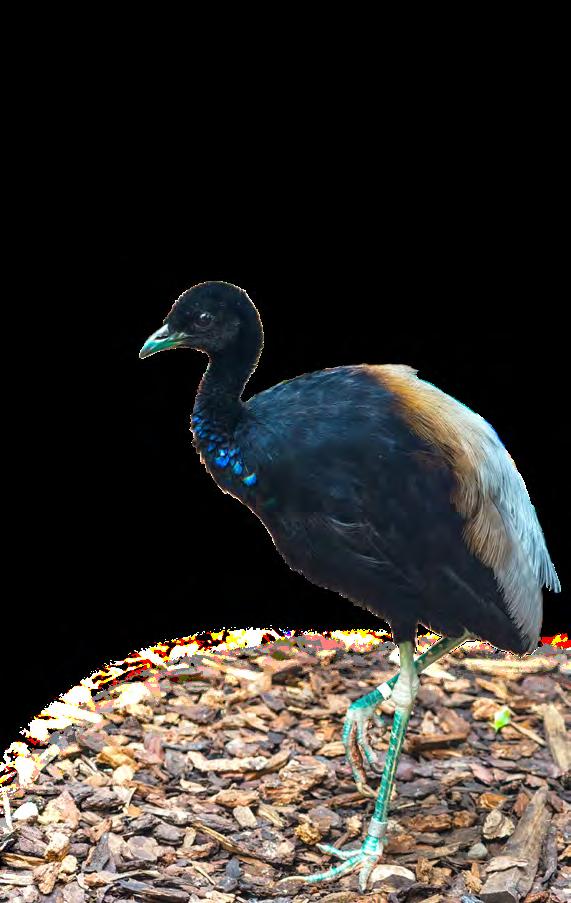
Kids Conservation Club Workshop
Two sessions to choose from: 10 a.m. or 11 a.m.
Are you ready for a morning of fun crafts and activities all about some furry, frolicking swimmers? The fall Kids Conservation Club Workshop is all about the North American river otter. Open to Kids Conservation Club members and up to two adults, choose from one of two 90-minute sessions to attend. Kids will participate in fun otter-themed crafts and activities to start the session, before taking a walk to Otter Passage to visit the Zoo’s North American river otters — Larkey, Clover, Shamrock, Cedric and Evie — and learn some fun and interesting facts about otters!
Kids Conservation Club members must RSVP with Becky Luft for the event by Sept. 6, either by email at beckyl@zoosociety.org or by phone at 414-479-2941
To sign up your child for the Kids Conservation Club, call 414-258-2333.
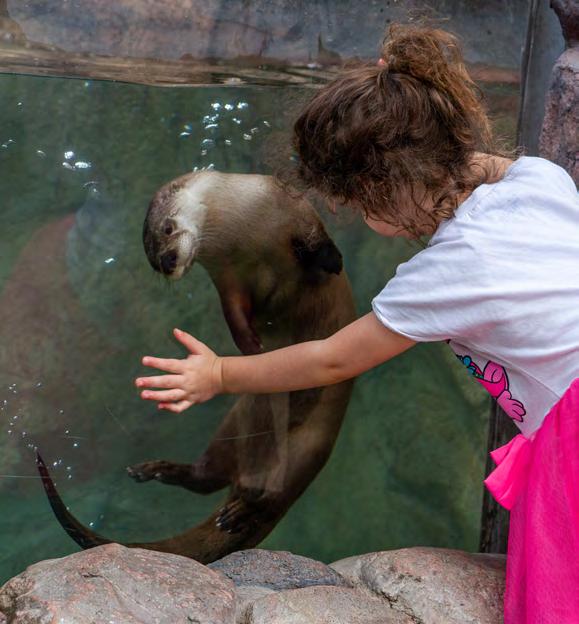


What’s the first animal that comes to mind when you think of Halloween? For most people, they will likely be thinking of bats. But while some people think of Halloween as a spooky holiday, bats are anything but! They are interesting creatures of the night that are important to our environment.
The Zoo is home to two species of bats that can be found in the Small Mammals Building: the common vampire bat and the straw-colored fruit bat. Both species, like most bats, are nocturnal. However, there are quite a few differences between the two species.
Common Vampire Bat: With a native range spanning from Mexico to Argentina, the common vampire bat is one of three species of vampire bat. Feeding mainly on the blood of livestock, vampire bats hunt at night while the animals are sleeping. It uses its razorsharp teeth to make a cut in the skin of the animal, and then laps up the blood before flying away. It can take up to 30 minutes for the bat to consume its fill of blood — roughly five teaspoons per feeding.
While they are considered pests by the people that live in their natural range due to their feeding on livestock and being carriers of the rabies virus, medical researchers highly value these bats! Vampire bats have an anticoagulant in their saliva to make it easier to feed on the blood of their prey. With that knowledge, a drug called draculin was
developed from the vampire bat saliva, and it is used to help prevent strokes and heart attacks in humans.
Straw-colored Fruit Bat: Unlike the smaller vampire bat, which measures 3.5 inches long and weighs 2 ounces with a 7-inch wingspan, the straw-colored fruit bat is quite a bit larger than its distant cousin. Weighing 8 to 12 ounces, they can grow up to 9 inches in length with a 30inch wingspan!
The straw-colored fruit bat’s native range is spread throughout central and southern Africa in forests and savannas. As the name suggests, they love to eat fruit, but they also will eat flowers, leaves and nectar. Interestingly, these bats can also be observed chewing on soft wood. It’s believed that they do this in order to obtain water. These bats are very important to their environment, as they act as pollinators by the incidental transfer of pollen when eating flowers and disperse fruit seeds through their excrement.
So this Halloween, instead of using bats as a scare tactic, thank them for all that they do for the environment and our well-being!


Zoo Pass members receive a 15% discount with code halloween15 and their membership number. OCT 17-20

Boo at the Zoo
Presented by Prairie Farms Dairy
5:30-9 p.m.
Calling all ghosts, ghouls, witches, monsters, cowboys or whatever else you dress up as. Show off your awesome costumes before Halloween at Boo at the Zoo.
Have a fun night at the Zoo, strolling by all sorts of Halloween decorations and hand-carved pumpkins on your way to a Creature of the Night talk. And don’t forget to bring your trick-or-treat buckets and bags! There will be candy and allergen-friendly stops along the Trick-or-Treat Trail at this spook-tacular event.
Tickets are required and can be purchased at milwaukeezoo.org starting in early September. Boo at the Zoo is an after-hours fundraising event for the Milwaukee County Zoo.
Tickets are required and can be purchased at milwaukeezoo.org.
Adult: $16, Child: $14
Lemur means “ghost” in a native language of Madagascar!
Page 10


Now-Oct. 5
Special summer exhibit, Dinosaur Discovery, sponsored by Sendik’s Food Market
Now-Sept. 2
Kohl’s Wild Theater’s summer season at the Zoo with free shows daily (except Mondays)*
Aug. 15-18
A La Carte at the Zoo, presented by Meijer*
Aug. 24
Animal Safari: Behind-the-scenes tours for animal sponsors
Sept. 8
Ride on the Wild Side Bike Ride, sponsored by Lifeway Foods
Sept. 22
Kids Conservation Club Workshop (pre-register)
Oct. 3
Zoo Brew (pre-register)
Oct. 5
Family Free Day, sponsored by Tri City National Bank & FOX6*
Oct. 17-20
Boo at the Zoo, presented by Prairie Farms Dairy
Nov. 2
Family Free Day, sponsored by Tri City National Bank & FOX6*
Nov. 6
Zoo Pass member registration for Spring Zoo Classes begins
*Zoo Pass members get free regular Zoo admission with their Zoo Pass. Those with Zoo Pass Plus also get free parking for one vehicle per membership per day. Platypus Circle members receive free admission and parking with their card.
